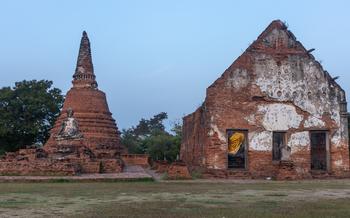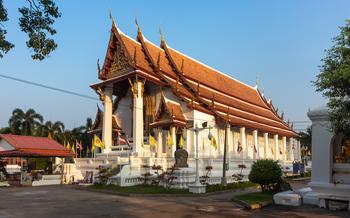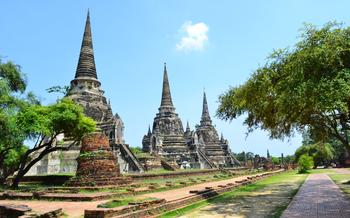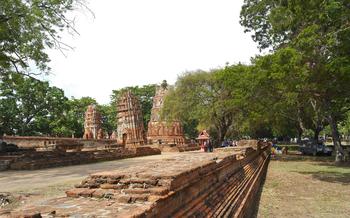
Phra Prang Sam Yot
- Phra Prang Sam Yot: A Historical and Architectural Gem
- Admission and Opening Hours
- Exploring the Temple Grounds
- Unique Features and Highlights
- Three Prangs and Their Architectural Significance
- Exquisite Carvings and Bas-Reliefs
- Buddha Images and Ancient Artifacts
- Monkey Population and Their Interactions
- Historical Context and Significance
- Cultural and Religious Practices
- Local Cuisine and Dining Options
- Shopping and Souvenirs
- Nearby Attractions and Activities
- Accommodation Options
- Safety and Security
- Responsible Tourism Practices
- Additional Tips and Considerations
- Insider Tip: Hidden Gems and Local Secrets
Phra Prang Sam Yot: A Historical and Architectural Gem
Phra Prang Sam Yot, meaning "Three Prang Temple," is an iconic historical site in Lopburi. Built in the 13th century during the Khmer Empire's reign, it holds immense historical and architectural significance. The temple features three majestic prangs, or towers, constructed in a unique architectural style blending Khmer and Thai influences. These prangs are adorned with intricate carvings and bas-reliefs depicting mythological scenes and Buddhist iconography.
Phra Prang Sam Yot has been a significant religious center throughout history and continues to be an important pilgrimage site for Thai Buddhists. Locals believe that the temple holds sacred powers, and many come to pray and make offerings for good luck and prosperity. The site has also played a crucial role in the cultural and religious development of the Ayutthaya Kingdom, as it was once part of the Khmer Empire's vast network of temples and monuments.
Admission and Opening Hours
Admission to Phra Prang Sam Yot is free of charge, making it easily accessible to travelers of all budgets. The temple is open to visitors daily from 8:00 AM to 6:00 PM, providing ample time to explore its grounds and admire its architectural grandeur. It is worth noting that the temple may be closed during certain religious holidays or special events, so it is always advisable to check in advance to avoid any inconvenience.
The temple complex is relatively small, and it is possible to explore it independently. However, for those interested in delving deeper into the history and significance of Phra Prang Sam Yot, guided tours are available. These tours, which can be arranged through local tour operators or directly at the temple, offer insights into the temple's construction, religious significance, and cultural context.
Exploring the Temple Grounds
The Phra Prang Sam Yot temple complex is a treasure trove of architectural wonders and serene spaces. As you enter the temple grounds, you'll be greeted by a spacious courtyard, adorned with manicured gardens and towering trees that provide a tranquil ambiance. The courtyard leads to the three prangs, which are the main structures of the temple.
Each prang is a sight to behold, with its intricate carvings and elegant spires reaching towards the sky. Take your time to admire the bas-reliefs that adorn the prangs, depicting scenes from Buddhist mythology and historical events. Don't forget to look out for the Buddha images enshrined within the prangs, each exuding a sense of serenity and spirituality.
Apart from the prangs, the temple complex also features several other structures and features that are worth exploring. The wihan, or assembly hall, is a large building that was once used for religious ceremonies and gatherings. The mondop, or library, houses ancient manuscripts and religious texts.
As you wander through the temple grounds, you'll come across pathways that lead you to different sections of the complex. Take a moment to pause and appreciate the serene atmosphere, the sound of birdsong, and the gentle breeze that rustles through the trees. The temple is a place of peace and tranquility, inviting you to slow down and immerse yourself in its spiritual essence.
Remember to be respectful and mindful of the temple's sanctity when taking photographs. Avoid using flash photography and be cautious not to disturb the monks or other visitors. Embrace the opportunity to capture the beauty and serenity of this sacred place, but always do so with respect and consideration.
Unique Features and Highlights
Three Prangs and Their Architectural Significance
The most striking feature of Phra Prang Sam Yot is its three prangs, towering over the temple grounds in all their grandeur. These prangs, or spires, are a defining characteristic of Khmer architecture and showcase the temple's rich history and cultural influences. The central prang, the tallest of the three, represents Mount Meru, the sacred mountain in Hindu and Buddhist cosmology. The two smaller prangs on either side symbolize the peaks of Mount Kailash, the abode of the Hindu god Shiva.
Exquisite Carvings and Bas-Reliefs
Phra Prang Sam Yot is adorned with intricate carvings and bas-reliefs that tell stories from Buddhist mythology and depict scenes from the life of Buddha. These intricate artworks showcase the exceptional craftsmanship and artistic prowess of the Khmer artisans who created them. Visitors can spend hours exploring the temple grounds, discovering hidden details and marveling at the beauty of these ancient carvings.
Buddha Images and Ancient Artifacts
Within the temple complex, visitors can find several Buddha images and ancient artifacts, each with its own unique story to tell. From serene Buddha statues exuding peace and tranquility to ancient inscriptions and relics providing glimpses into the temple's past, these artifacts offer a tangible connection to the history and spirituality of Phra Prang Sam Yot.
Monkey Population and Their Interactions
One of the most unique aspects of Phra Prang Sam Yot is its resident monkey population. These playful and mischievous creatures add a touch of charm and entertainment to the temple grounds. Visitors can observe the monkeys interacting with each other, swinging through the trees, and sometimes even posing for photographs. While the monkeys can be entertaining, it's important to remember that they are wild animals and should be treated with respect and caution.
Historical Context and Significance
Phra Prang Sam Yot played a significant role in the Ayutthaya Kingdom, a powerful Siamese kingdom that ruled over much of central Thailand from the 14th to the 18th centuries. The temple served as a royal temple and was closely associated with the monarchy. It was considered a sacred site where important ceremonies and rituals were held.
The temple's architecture reflects the cultural exchanges and influences that occurred during the Ayutthaya period. The design incorporates elements of both Khmer and Thai architecture, showcasing the kingdom's receptiveness to foreign influences while maintaining its own unique identity.
Phra Prang Sam Yot has undergone numerous transformations and renovations throughout its history. It was initially constructed during the reign of King Narai and underwent significant expansions and modifications during subsequent reigns. These changes reflect the evolving religious and cultural landscape of the Ayutthaya Kingdom.
In the 18th century, the temple was damaged during the Burmese invasion of Ayutthaya. However, it was later restored and continues to be an important religious site for the local community. The temple's resilience and longevity are testaments to its historical and cultural significance.
Cultural and Religious Practices
Phra Prang Sam Yot holds deep cultural and religious significance for the people of Lopburi and Thailand as a whole. It serves as an active Buddhist temple, where monks reside and conduct daily ceremonies and rituals. Visitors are welcome to observe these ceremonies, which typically involve chanting, meditation, and the offering of alms to the monks.
Local beliefs and traditions associated with the temple are deeply intertwined with the Buddhist faith. Devotees often make offerings of flowers, candles, and incense to the Buddha images within the temple grounds. They also engage in merit-making activities, such as donating to the temple or participating in temple restoration projects.
Respectful behavior is expected within the temple premises. Visitors should dress modestly, remove their shoes before entering the temple buildings, and refrain from loud conversations or disruptive behavior. It is also customary to bow or wai in front of the Buddha images as a sign of respect.
By understanding and respecting the cultural and religious practices associated with Phra Prang Sam Yot, visitors can contribute to preserving the temple's sacred atmosphere and fostering a deeper appreciation for the local culture.
Local Cuisine and Dining Options
After exploring the ancient wonders of Phra Prang Sam Yot, tantalize your taste buds with the delectable culinary offerings that Lopburi has to offer. Just a stone's throw from the temple, you'll find a plethora of restaurants and street food stalls, each vying for your attention with their aromatic creations.
Indulge in the lip-smacking flavors of traditional Thai cuisine, where sweet, sour, salty, and spicy notes dance harmoniously on your palate. Must-try dishes include Pad Thai, a stir-fried rice noodle dish with a tangy tamarind sauce, and Tom Yum Goong, a spicy and sour soup with succulent shrimp.
For vegetarians and vegans, there are plenty of options to satisfy your cravings. Sample the hearty Khao Pad Sapparot, a fried rice dish with pineapple, cashew nuts, and tofu, or savor the rich flavors of Massaman Curry, a mild and creamy curry with potatoes, carrots, and peanuts.
When it comes to street food, Lopburi is a haven for culinary adventurers. From grilled meats on skewers to crispy roti pancakes, there's something to suit every palate. Don't miss the chance to try Khanom Jeen, a noodle dish served with a variety of flavorful curries and toppings.
Remember to embrace the local customs when dining in Lopburi. Respect the food and the people who prepare it, and don't be afraid to ask for recommendations or try something new. With its vibrant food scene and friendly locals, Lopburi is a culinary paradise waiting to be explored.
Shopping and Souvenirs
After immersing yourself in the history and spirituality of Phra Prang Sam Yot, take some time to explore the nearby markets and shops for unique souvenirs and local handicrafts. Just a short walk from the temple, you'll find an array of stalls selling everything from handmade textiles and pottery to intricate Buddhist amulets and religious items.
Bargaining is a common practice in Thailand, so don't be afraid to negotiate a fair price. However, always do so respectfully and with a smile. Supporting local artisans and businesses is a great way to give back to the community and ensure the preservation of traditional crafts.
One popular souvenir to look out for is the distinctive Lopburi monkey figurine. These charming figurines, often made of ceramic or wood, depict the playful monkeys that have become synonymous with the temple. They make for a unique and memorable gift for friends and family back home.
When shopping in Lopburi, remember to be mindful of local customs and traditions. Dress modestly, avoid haggling aggressively, and always ask permission before taking photos of people or sacred objects. By showing respect and understanding, you'll have a more enjoyable and rewarding shopping experience.
Nearby Attractions and Activities
Beyond the captivating allure of Phra Prang Sam Yot, Lopburi offers a tapestry of historical and natural wonders waiting to be explored. Just a stone's throw away lies the awe-inspiring Wat Phra Si Ratana Mahathat, renowned for its colossal reclining Buddha, exuding an aura of serenity and grandeur. History enthusiasts will delight in delving into the ancient city of Ayutthaya, a UNESCO World Heritage Site adorned with magnificent temples and palaces, each narrating tales of Thailand's glorious past.
Nature lovers can embark on a rejuvenating journey to Khao Yai National Park, a verdant expanse teeming with diverse wildlife, cascading waterfalls, and panoramic vistas. For those seeking a spiritual retreat, the tranquil Wat Tham Pha Phluang beckons with its serene temple nestled amidst picturesque limestone cliffs.
Immerse yourself in the vibrant local culture by attending one of the many festivals and events that grace Lopburi's calendar. From the lively Monkey Banquet, where hundreds of monkeys feast on a lavish spread, to the colorful Pha Phum Fair, showcasing traditional Thai handicrafts and performances, these events offer a glimpse into the heart and soul of this captivating region.
Accommodation Options
Lopburi offers a range of accommodation options to suit every budget and preference.
- Budget-Friendly Options: For backpackers and budget travelers, there are guesthouses and hostels that provide basic but comfortable rooms at affordable prices. These establishments often have shared bathrooms and common areas, allowing guests to socialize and meet fellow travelers.
- Mid-Range Hotels: For those seeking a balance between comfort and affordability, mid-range hotels offer clean and well-equipped rooms with private bathrooms. Many of these hotels are located within walking distance of the city center and major attractions, providing convenience and ease of exploration.
- Luxury Resorts: For a luxurious and indulgent stay, Lopburi has several upscale resorts and boutique hotels that offer a range of amenities and services. These establishments typically feature spacious rooms, private balconies or patios, swimming pools, and on-site restaurants.
Tips for Finding the Best Deals and Locations:
- Book in Advance: To secure the best rates and availability, especially during peak tourist seasons, it's advisable to book your accommodation in advance. Online booking platforms and travel agents often offer discounted rates and promotions.
- Consider Location: When choosing a hotel, consider its proximity to the attractions and areas you plan to visit. Staying close to the city center or near public transportation hubs can save you time and money on transportation.
- Read Reviews: Before making a reservation, read reviews from previous guests to get an idea of the hotel's cleanliness, service, and overall atmosphere.
Safety and Security
Thailand is generally a safe country for travelers, but as with any destination, it's essential to exercise caution and common sense. Petty crimes such as pickpocketing and bag snatching can occur, especially in crowded areas, so be vigilant and keep your belongings close. Be wary of scams targeting tourists, such as fake tour guides or tuk-tuk drivers who overcharge.
When visiting temples, dress respectfully and avoid wearing revealing clothing. Be mindful of local customs and traditions, such as removing your shoes before entering a temple's inner sanctum. Respect the religious significance of the site and refrain from loud or disruptive behavior.
While monkeys are a charming part of Lopburi's landscape, they can also be mischievous and aggressive if not handled properly. Avoid feeding them or interacting with them closely. Keep your distance and never turn your back on them.
Always stay informed about local news and events and follow the advice of local authorities. By being aware of your surroundings, taking precautions, and respecting local customs, you can ensure a safe and enjoyable visit to Phra Prang Sam Yot and Lopburi.
Responsible Tourism Practices
As you explore Phra Prang Sam Yot and other sacred sites in Thailand, it is essential to practice responsible tourism. Here are some tips to help you minimize your impact and contribute to the preservation of these cultural and historical treasures:
-
Tread Lightly: Be mindful of your footsteps and avoid stepping on ancient structures, carvings, or delicate plants. Stay on designated paths and walkways to prevent damage to the grounds.
-
Respect the Wildlife: Phra Prang Sam Yot is home to a playful monkey population. While they are entertaining to watch, remember that they are wild animals. Maintain a safe distance, avoid feeding them, and do not attempt to touch or provoke them.
-
Reduce Waste: Bring reusable water bottles and minimize single-use plastic consumption. Properly dispose of any trash in designated bins to keep the temple grounds clean and free of litter.
-
Support Local Businesses: Opt for local restaurants, shops, and tour operators that support the community. Your patronage helps preserve local traditions and generates income for the people who call Lopburi home.
-
Respect Local Customs: Observe local customs and dress appropriately when visiting temples. Remove your shoes before entering sacred spaces, avoid pointing your feet at Buddha images, and speak in a respectful tone.
Additional Tips and Considerations
When visiting Phra Prang Sam Yot, as well as any other temple in Thailand, it is important to dress appropriately. Shoulders and knees should be covered, and footwear should be removed before entering the temple grounds. It is also important to be mindful of the weather conditions, as the temple is mostly exposed to the sun. Sunscreen, hats, and sunglasses are recommended.
Thailand is a predominantly Buddhist country, and it is important to be respectful of local customs and traditions. This includes being mindful of your behavior and language, and avoiding any actions that may be considered disrespectful or offensive. Patience and cultural sensitivity are key to having a positive and enriching experience.
Language barriers can be a challenge when traveling in Thailand, but there are several ways to overcome this. Many people in the tourism industry speak basic English, and there are also a number of language learning apps and translation services available. With a little effort, you can easily communicate with locals and get the most out of your visit.
Insider Tip: Hidden Gems and Local Secrets
Beyond the main attractions, Lopburi offers hidden gems and local secrets that are worth exploring. For photography enthusiasts, venture into the lesser-known corners of the temple complex to capture unique perspectives and hidden details. Attend local festivals and events to immerse yourself in the vibrant culture and traditions of Lopburi. These events often showcase traditional performances, local cuisine, and handicrafts.
Seek out off-the-beaten-path attractions such as the nearby Wat Sao Tong Thong, a beautiful temple adorned with intricate murals and sculptures. For a unique culinary experience, try the local specialty of "Kai Yang Lopburi," a succulent grilled chicken dish that is a local favorite. Embrace the opportunity to interact with the friendly locals, who are always happy to share stories and insights about their town.




